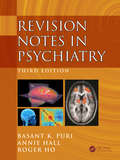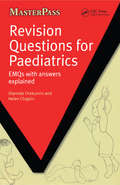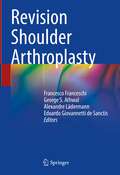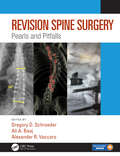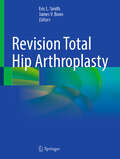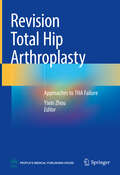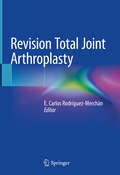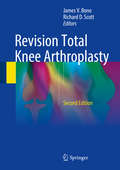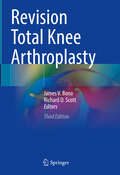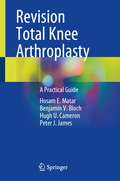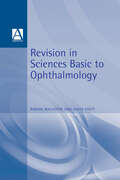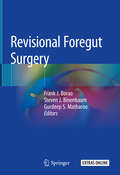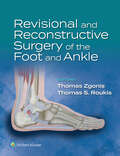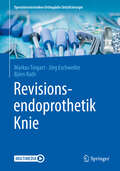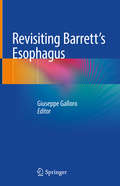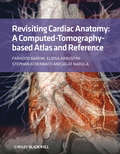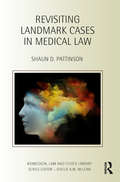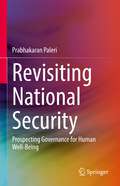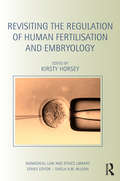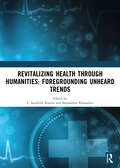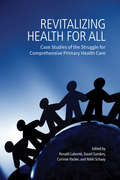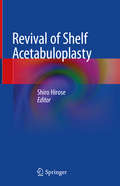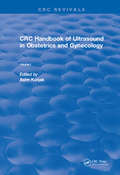- Table View
- List View
Revision Notes in Psychiatry
by Basant Puri Annie Hall Roger HoRevision Notes in Psychiatry, Third Edition continues to provide a clear and contemporary summary of clinical psychiatry and the scientific fundamentals of the discipline. It is an essential study aid for all those preparing for postgraduate examinations in psychiatry and a superb reference for practising psychiatrists.Structured to follow the enti
Revision Questions for Paediatrics: EMQs with Answers Explained
by Olamide OrekunrinThis revision tool helps readers strengthen their existing knowledge of childhood disorders through Extended Matching Questions (EMQs) on topics frequently asked in Paediatrics examinations, ranging from neonatology to emergency medicine and public health. Detailed answers in each section build comprehension and knowledge. Many medical schools now examine undergraduates using EMQs, but they also feature highly in postgraduate examinations. This revision aid will therefore also be useful to those preparing for postgraduate examinations such as the Diploma of Child Health (DCH) and Membership of the Royal College of Paediatrics and Child Health (MRCPCH), as well as foundation doctors on their first paediatric rotations and all those wishing to consolidate their knowledge and understanding of Paediatrics.
Revision Shoulder Arthroplasty
by Francesco Franceschi George S. Athwal Alexandre Lädermann Edoardo Giovannetti de SanctisFilling an unmet need this book covers all relevant aspects of Revision Shoulder Arthroplasty. Edited by internationally renowned experts in the field it offers the reader solid theoretical and practical knowledge to address this complex surgical procedure.The chapters are grouped into seven sections each addressing a macro-topic: arthroplasty failure, pre-operative planning and operative techniques, the failed glenoid and humerus, infections, instability and soft tissue management, and surgical outcomes. This book offers a timely and up-to-date resource for shoulder surgeons wishing to deepen their knowledge of this complex and challenging procedure.
Revision Spine Surgery: Pearls and Pitfalls
by Alexander R. Vaccaro Gregory D. Schroeder Ali A. BaajRevision spine surgery requires a unique skill set different from performing a primary operation. Understanding when a simple revision is sufficient, when a more complex approach is needed, or when a non-surgical option should be considered is critical to good patient care and outcomes. In this first book to focus exclusively on the complex topic o
Revision Surgery of the Foot and Ankle: Surgical Strategies and Techniques
by Mark J. Berkowitz Michael P. Clare Paul T. Fortin Lew C. Schon Roy W. SandersThis unique text utilizes a bulleted, case-based approach to present a variety of surgical strategies and techniques for tackling the many challenges posed by revision foot and ankle surgery.The book is organized thematically into sections on the forefoot, trauma, sports injuries, and arthritis and reconstruction, with each chapter including key takeaway points, discussions of evaluation, surgical planning, and the cases themselves. Specific revision topics presented include first MTP joint fusion, failed bunion and hammertoe, failed Lisfranc and fifth metatarsal fracture, failed flatfoot and subtalar fusion, and nonunion of ankle fusion and failed total ankle replacement, among others. The challenge of revision foot and ankle surgery is that there are countless ways for a surgery to fail. Therefore, presenting as many different scenarios as possible and techniques to address them is the main advantage of the book. Practical and user-friendly, Revision Surgery of the Foot and Ankle will prove indispensable to both the young and veteran orthopedic surgeon preparing for these challenging surgical interventions.
Revision Total Hip Arthroplasty
by James V. Bono Eric L. SmithRevision total hip arthroplasty (THA) helps solve the reconstructive challenges facing surgeons today. This comprehensive text encompasses the necessary background and foundation for the reader to better understand the principles of revision THA, highlighting the preferred techniques and solutions of regional centers across the US that are known for excellence in revision THA. Across eleven thematic sections, this book presents modern techniques to solve common problems, with an emphasis on intra-operative and clinical photos. The opening section discusses general considerations and principles of revision THA, including the global burden, soft tissue balancing and biomechanics, and biomaterials. The next few sections cover evaluation, pre-operative planning and surgical exposures, then dive into acetabular, femoral and trochanteric reconstruction techniques. An entire section is dedicated to author-preferred techniques for managing instability, aseptic loosening, periprosthetic infection and fracture, corrosion, implant failure and more. The final sections discuss methods to minimize complications, unique considerations and special considerations for revision THA, from abductor tears to the role of physical therapy. This well-illustrated, state-of-the-art-text will prepare orthopedic surgeons of every level to solve unique and common etiologies of failed THA, making this a practical guide for every revision surgeon.
Revision Total Hip Arthroplasty: Approaches to THA Failure
by Yixin ZhouCompared with primary total hip arthroplasty, revision total hip arthroplasty is challenging due to more complicated pre-operative planning, longer operating time, more blood loss, more uncertainties during operation, and uncertainties in clinical outcome. This book presents up-to-date information on revision total hip arthroplasty covering different failures for primary total hip arthroplasty. Each chapter starts with the principles of diagnosis and treatment of specific THA failure mechanism, and then several typical cases. Each case includes history report, physical examination, laboratory test, radiology, failure mechanism, reconstruction strategy, operation record, post-operative follow-up, tips & tricks, and pitfalls. Written by experts with wealthy of clinical experience, it will be useful reference for arthroplasty surgeons, attending orthopedic surgeons, residents, attendants, and researchers and engineers from orthopedic industry.
Revision Total Joint Arthroplasty
by E. Carlos Rodríguez-MerchánThis comprehensive book is devoted to revision total joint arthroplasty and provides state-of-the-art guidance in a field where level-I evidence is difficult to produce.In the book’s respective sections, each of which focuses on a specific joint – the knee, hip, shoulder, elbow, or ankle – readers will learn how to manage these complex surgical techniques. Each section thoroughly describes the epidemiology, causes and surgical techniques, as well as clinical results and complications. Filling an important gap in a rapidly evolving field, this book will appeal to all healthcare workers involved in the care of affected patients, including orthopedic surgeons and fellows, rehabilitation specialists, pain physicians, podiatrists and nurses.
Revision Total Knee Arthroplasty
by James V. Bono Richard D. ScottEdited by two leading authorities in the field, this volume is a technique-oriented 'how-to' guide to an increasingly performed procedure, corrective surgery for the failed total knee arthroplasty. This book offers an in-depth, comprehensive approach for orthopedic surgeons, sports medicine specialists, and residents to revision total knee arthroplasty and its complications. More than 350 illustrations 60 in full color complement detailed descriptions of surgical procedures. This book offers clinical pearls on topics such as diagnosis and evaluation, pre-op planning and component selection, surgical approach, revision technique, post-op complications, and salvage all covered by top experts in the field. "
Revision Total Knee Arthroplasty
by James V. Bono Richard D. ScottNow in a fully revised and updated third edition, this comprehensive text covers all aspects of revision total knee arthroplasty (TKA), complete with step-by-step descriptions of surgical techniques. Sensibly divided into four thematic sections, part I discusses evaluation and diagnosis of the failed TKA, including imaging, updates on implant bearings, and rationale for reoperation. General principles of revision surgery are presented in part II, addressing skin and extensile exposure, component removal, allografts, metaphyseal sleeves and cones, femoral and tibial alignment, and restoration of stability. Part III presents the many special considerations that come into play with revision TKA, including periprosthetic fracture, infection, stiffness and other post-operative complications and complexities. The role of arthrodesis and the economics of revision TKA are also elucidated. A final, brand new section describes cutting edge topics for TKA in the near future, such as patient specific 3D implants, the use of robotics, and sensor and digital technology. Utilizing the most current evidence and generously illustrated, orthopedic surgeons, sports medicine specialists, residents and fellows alike will find Revision Total Knee Arthroplasty, Third Edition a thorough and informative resource when treating the patient following knee replacement surgery.
Revision Total Knee Arthroplasty: A Practical Guide
by Hosam E. Matar Benjamin V. Bloch Hugh U. Cameron Peter J. JamesThis book is a practically applicable guide to the use of revision total knee arthroplasty. Demand for primary total knee arthroplasty (TKA) continues to rise, with some estimates predicting this to be as high as 400% than it currently is, and this will inevitably lead to increased demand for revision surgery. Furthermore, this is a sub-specialist area of arthroplasty that is complex and challenging with high failure rates, meaning that there is a real need to improve the outcomes of these procedures. Within this book, the chapters focus on a particular subject area focusing on how to successfully perform a procedure in a step-by-step manner in a variety of scenarios from condylar revisions to salvage cases. Topics covered include how to use surgical techniques in instances of periprosthetic distal femur fractures and manage infections where bone loss has been significant. Long-term outcome data is also presented to enable the reader to develop a deep understanding of where a particular strategy might be most effective. Revision Total Knee Arthroplasty: A Practical Guide concisely details how to use the techniques covered in all aspects of revision knee surgery, making it an indispensable resource for all those involved in the care of these patients or who use these techniques in their day-to-day clinical practice.
Revision in Sciences Basic to Ophthalmology (Medical Finals Revision Series)
by Raman Malhotra David EastyThis is a self-assessment book for candidates for postgraduate examinations in ophthalmology, principally the FRCOphth Part I. It covers all of the sciences fundamental to ophthalmology: anatomy (60 questions), physiology (93 questions), pharmacology (36), pathology (33) and microbiology (42). Questions are grouped according to specialty area, followed by true/false answers that are all supported with concise explanations. The book can therefore be used for learning as well as practice.The book's most innovative feature is the set of 21 structed essay plans, covering the major topics of concern in this field. It is notoriously difficult to provide model answers to essay questiosn, but here the authors have developed a new, highly visual approach with the consistent use of icons, to provide an at-a-glance understanding.
Revisional Foregut Surgery
by Frank J. Borao Steven J. Binenbaum Gurdeep S. MatharooThis book is divided into 3 parts, each containing chapters that cover commonly encountered clinical scenarios of reoperative surgery. These parts include revisional bariatric surgery, reoperation for complications of bariatric surgery, and revisional anti-reflux and gastric procedures. The information covered discusses existing literature and best-practices in patient care, with a focus on operative technique, pitfalls, and post-operative complications. The aim of this book is to provide the reader with information on how to successfully manage a patient requiring reoperation. Chapters also highlight the difference in patient outcomes when the procedures are completed in a minimally invasive approach rather than an open approach.Revisional Foregut Surgery serves as a valuable resource for medical students, surgical residents, fellows, and attending surgeons seeking advice and guidance on reoperative upper gastrointestinal surgery and their related complications.
Revisional and Reconstructive Surgery of the Foot and Ankle
by Thomas S. Roukis Thomas ZgonisComprehensive and highly illustrated, Revisional and Reconstructive Surgery of the Foot and Ankle is a problem-based guide for both orthopaedic and podiatric foot and ankle surgeons who perform revision surgeries for complications resulting from foot and ankle procedures. Edited by Dr. Thomas Zgonis, author of the well-regarded Surgical Reconstruction of the Diabetic Foot and Ankle, along with co-editor Dr. Thomas S. Roukis, this up-to-date reference provides authoritative, easy-to-follow guidance from recognized experts in the field.
Revisionsendoprothetik Knie (Operationstechniken Orthopädie Unfallchirurgie)
by Markus Tingart Jörg Eschweiler Björn RathDieses Buch gibt einen Überblick über die Hauptversagensgründe von Knieprothesen und bietet in prägnanten Texten und Grafiken einen Leitfaden zur Indikationsstellung und zur operativen Durchführung von Revisionseingriffen am Kniegelenk. Der Schwerpunkt liegt dabei auf der Praxis: Schritt für Schritt wird das How to do beschrieben. Darüber hinaus vermitteln die Autoren zahlreiche Tipps und Tricks, die für einen erfolgreichen Operationsverlauf essentiell sind. Neben den brillanten Grafiken und Fotos illustriert und erläutert ein 10-minütiges Video alle entscheidenden Schritte am Beispiel eines exemplarischen Revisionseingriffes. So ist die Umsetzung der Theorie in die Praxis auf kurzem Weg möglich.
Revisiting Barrett’s Esophagus
by Giuseppe GalloroThis book focuses on Barrett’s Esophagus (BE), a clinical condition that must be evaluated in all patients affected by chronic GERD, and with an important link to esophageal cancer. Divided into four sections (morphological background, epidemiology and natural history, diagnosis, and treatments), this handy volume provides the latest indications regarding endoscopic approaches (first level and advanced endoscopy), pathological studies (pathology and molecular biology), and state-of-the-art therapeutic options (medical, endoscopic, and surgical) for BE. As such, it offers a valuable reference guide for all professionals involved in the management of BE (gastroenterologists, endoscopists, pathologists and surgeons), offering them a comprehensive overview and deeper understanding of this seemingly superficial disease.
Revisiting Cardiac Anatomy
by Farhood SaremiThis new atlas represents a fresh fresh approach to cardiac anatomy, providing images of unparalleled quality, along with explanatory text, to show in vivo heart anatomy and explain the clinically relevant underlying anatomic concepts. In spite of amazing proliferation of information on the Internet and multiple websites filled with up-to-date information, there is no similarly detailed and systematic compilation of morphological imaging with CT. Organized for both systematic learning and to serve as a quick, yet detailed reference for specific clinical questions, this book is an invaluable resource for medical students and residents, cardiologists, and especially surgeons, interventionalists and electrophysiologists, who depend on ever more detailed imaging support in order to successfully perform increasingly complex coronary and noncoronary structural interventions and other procedures.
Revisiting Landmark Cases in Medical Law (Biomedical Law and Ethics Library)
by Shaun D. PattinsonIs it lawful for a doctor to give a patient life-shortening pain relief? Can treatment be lawfully provided to a child under 16 on the basis of her consent alone? Is it lawful to remove food and water provided by tube to a patient in a vegetative state? Is a woman’s refusal of a caesarean section recommended for the benefit of the fetus legally decisive? These questions were central to the four focal cases revisited in this book. This book revisits nine landmark cases. For each, a new leading judgment is attributed to an imagined judge, Athena, who operates within the constraints of the legal system of England and Wales. Her judgments accord with an innovative legal theory, referred to as ‘modified law as integrity’, and are linked as a line of precedent. The result is a re-spinning of extant judicial threads into a web of legal principles with a greater claim to coherence and defensibility than those in the original cases. The book will be of great interest to scholars and students of medical law, criminal law, bioethics, legal theory and moral philosophy.
Revisiting National Security: Prospecting Governance for Human Well-Being
by Prabhakaran PaleriThis book examines the evolving concept of national security and how human systems could be governed in an ever turbulent and dynamic world. It takes a revised look at the concept of national security, previously researched and identified by the author, based on the present context but with a futuristic appreciation of governance, primarily national but extended to global perspectives, in the modern and dynamically shifting world. The book emphasises the need for governments to maximise national security for the well-being of their people. The concept of national security is taken as the key subject of national governance which is extendable to global governance wherein national security is not only the physical or military security alone but also the overall well-being of the people of a nation. This book explores how national security can be achieved by balancing its various elements in different terrains where the game of governance is played in national as well as global perspective. It also presents additional findings and observations to show that the approach is transformative, redefining the key knowledge paradigms. This book is relevant for policy makers, students, researchers and academics who wish to explore and rethink their approach towards governing the human systems, whose well-being is the responsibility of governments.
Revisiting the Regulation of Human Fertilisation and Embryology (Biomedical Law and Ethics Library)
by Kirsty HorseyThe Human Fertilisation and Embryology Act 2008 was a major update to the UK’s laws on the use and regulation of reproductive technology and assisted reproduction. Since the enactment of the new law, the sector’s regulatory body, the Human Fertilisation and Embryology Authority (HFEA), has also consulted on various related topics including barriers to egg and sperm donation in the UK, multiple births/single embryo transfer and using IVF technology to prevent mitochondrial disease. This book critically considers recent developments in human fertilisation legislation, asking whether the 2008 Act has achieved its stated aim of being fit for purpose. Bringing together a range of international experts, the book evaluates the fresh risks and challenges emerging from both established and existing technologies and techniques in the field of human fertilisation and embryology, as well as offering valuable insights into the social and regulatory challenges that lie ahead. Key topics include problems with DIY assisted conception; the lack of reform in respect of the regulation of surrogacy arrangements; and mitochondrial DNA transfer. As a review of the status of assisted reproduction legislation, this book will be of great use and interest to students, researchers and practitioners in medical law, bioethics, medicine and child welfare.
Revitalizing Health Care Ethics: The Clinician’s Voice
by Stephen Scher Kasia KozlowskaThis open access book explores the origins and development of the clinician’s moral voice and how that voice is embedded in the informal ethical discourse of everyday health care. This moral voice, developed over the course of a lifetime—including through professional education and practice—enables clinicians to understand and address the ethical issues that arise in their everyday work with patients, families, and colleagues. The early chapters explain how health care students move from outsiders to insiders—members of the distinct moral and professional communities that define each particular field of health care. The book describes how students, trainees, and clinicians draw on and extend their own existing intellectual, emotional, and moral capacities, and how they use these capacities to address the daily challenges, ethical and otherwise, that arise in the clinic. This approach is designed both to empower clinicians and to inform bioethicists and others in their attempts to work more effectively within clinical settings. This book is available open access under a CC BY-NC-ND 4.0 license.
Revitalizing Health Through Humanities: Proceedings of the International Conference on Health and Humanities: Exploring Uncharted Terrains in Literary Paradigms
by Barnashree Khasnobis Sreedevi Santhosh L. Santhosh KumarHealth Humanities in contemporary times has enabled exploration of the unexplored chartered terrains in literary paradigms. Scholars in the field of Humanities and Sciences have been engaging with the praxis of applying concepts from both disciplines revising the approach towards Health Care and Humanities. Due to interdisciplinary and multidisciplinary methodologies of reading literary texts, they have been reinforcing a paradigm shift from the conventional understanding of narratives in Literature and Health Care. Traditional discursive boundaries between the disciplines of Health and Humanities are collapsing due to a comprehensive and nuanced interpretation of the shared ontological foundation between the two – Humanism. Terminologies like Displacement, Dislocation, and Disjunction unite Health and Humanities and they also make the unknown, known. Health Humanities explores the different multitudes of narration in the literary arena and it represents diverse voices of literature. It also showcases the importance of re-reading a text owing to its autotelic status. The authors who have contributed chapters for this book have meticulously selected diverse texts and contexts, embedded in the dynamism of Health Humanities. This book is an impetus for academicians from the field of Humanities and Sciences who desire to venture into new epistemes towards Health Humanities.
Revitalizing Health for All: Case Studies of the Struggle for Comprehensive Primary Health Care
by David Sanders Corinne Packer International Development Research Centr Nikki Schaay Ronald LabontéThe concept of Comprehensive Primary Health Care focuses on health system efforts to improve equity in health care access, community empowerment, participation of marginalized groups, and actions on the social determinants of health. Despite its existence since the late 1970s very few studies have been able to highlight the outcomes of this concept, until now. Revitalizing Health for All examines thirteen cases of efforts to implement CPHC reforms from around the globe including Australia, Brazil, Democratic Republic of Congo, Iran, South Africa, and more. The findings presented in this volume originate from an international action-research set of studies that utilized triads of senior and junior researchers and knowledge users from each country’s public health system. Primary health care reform is an important policy discourse both at the national level in these countries and in the global conversations, and this volume reveals the similarities among CPHC projects in diverse national contexts. These similarities provide a rich evidence base from which future CPHC reform initiatives can draw, regardless of their country.
Revival of Shelf Acetabuloplasty
by Shiro HiroseThis book provides an up-to-date overview of shelf acetabuloplasty, a traditional procedure for acetabular dysplasia.Originally, shelf acetabuloplasty was mainly intended for the treatment of developmental dysplasia of the hip (DDH) in children and adolescents. However, secondary osteoarthritis of the hip due to DDH is more common than primary osteoarthritis, and shelf acetabuloplasty was subsequently applied to such cases in adults. Recently, periacetabular pelvic osteotomies, such as the rotational acetabular osteotomy have established themselves and are broadly indicated as joint-preserving operations for secondary hip osteoarthritis. With the increased interest in pelvic osteotomies, the role of shelf acetabuloplasty as a reliable and safe procedure now needs to be redefined. Each chapter was prepared by an expert in his or her field. The authors highlight the essence of the indication, discuss advanced and cutting-edge techniques, and assess the outcomes of shelf acetabuloplasty. Taken together, they provide a valuable contribution to hip surgery.
Revival: CRC Handbook of Ultrasound in Obstetrics and Gynecology, Volume I (CRC Press Revivals)
by Asim KurjakThis practical, two-volume handbook is the first to illustrate the use of transvaginal color doppler in obstetrics and gynecology. It provides a critical look at state-of-the-art ultrasound techniques and equipment and serves as a comprehensive reference with numerous black/white and color ultrasonograms, tables and graphs. The volumes include extensive literature citations which assist the investigator in finding more in-depth references. This work focuses on the recent remarkable expansion in both diagnostic techniques and clinical applications. It reports findings based on an unusually large patient population over a long period of time. It presents the accuracy and limitations of various aspects of ultrasound. This important publication is especially helpful for clinicians and researchers.
